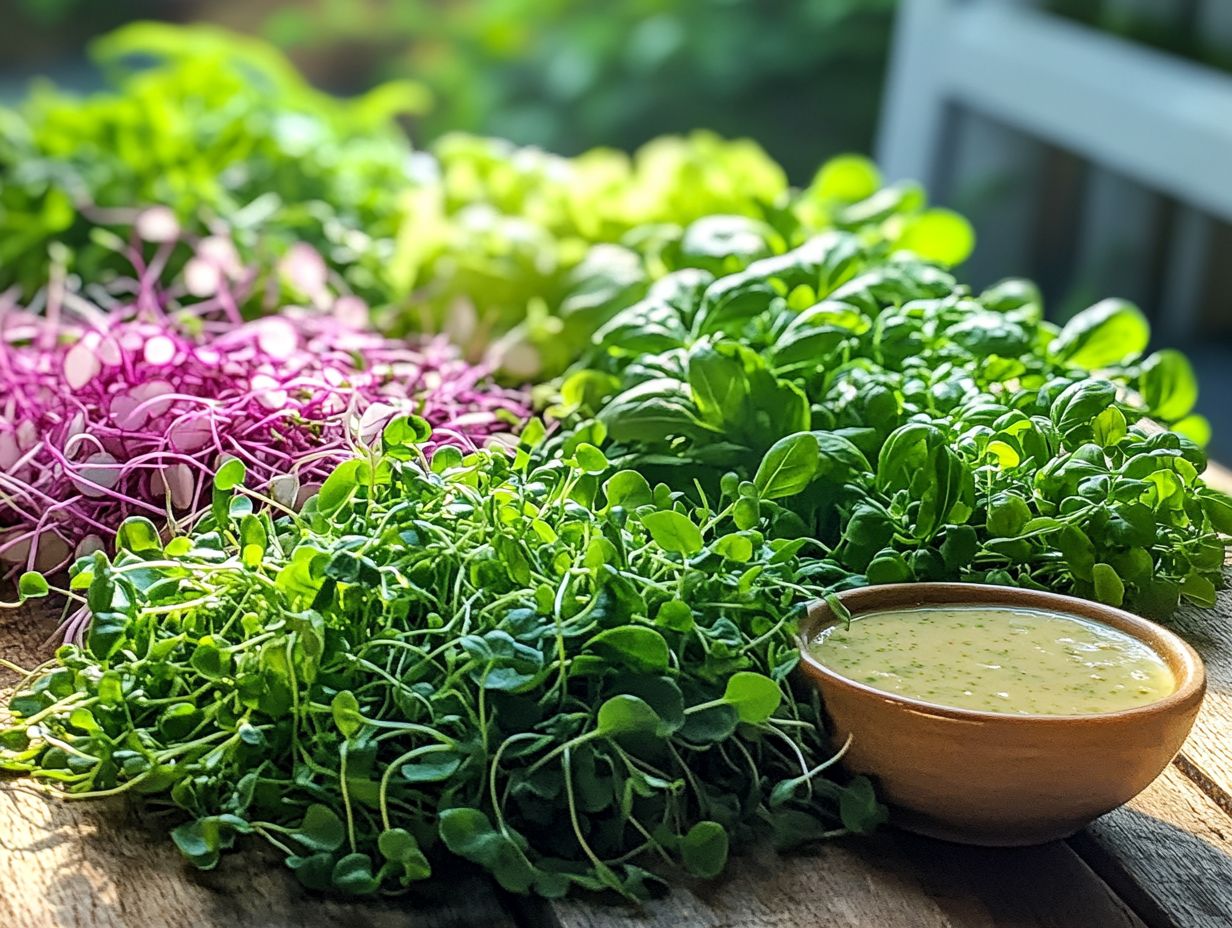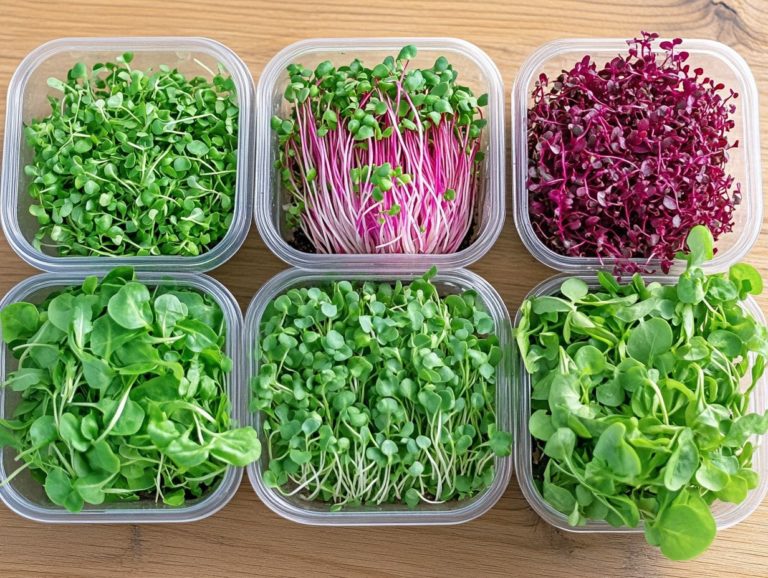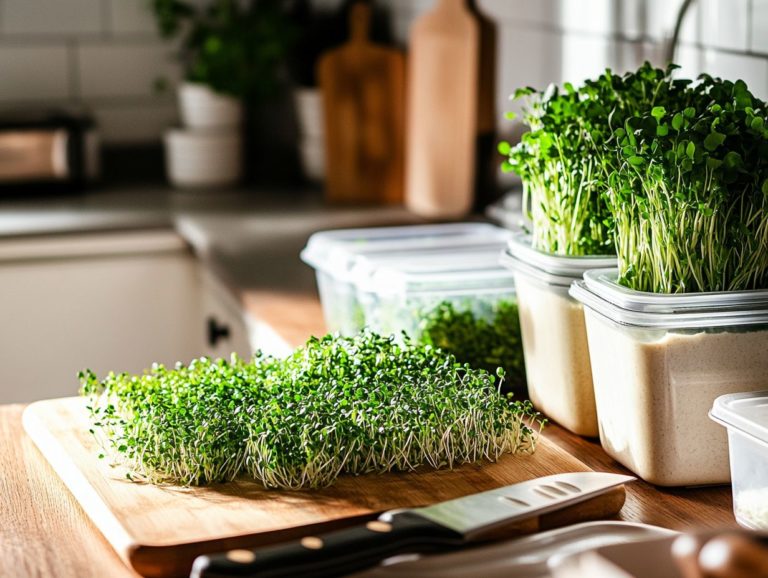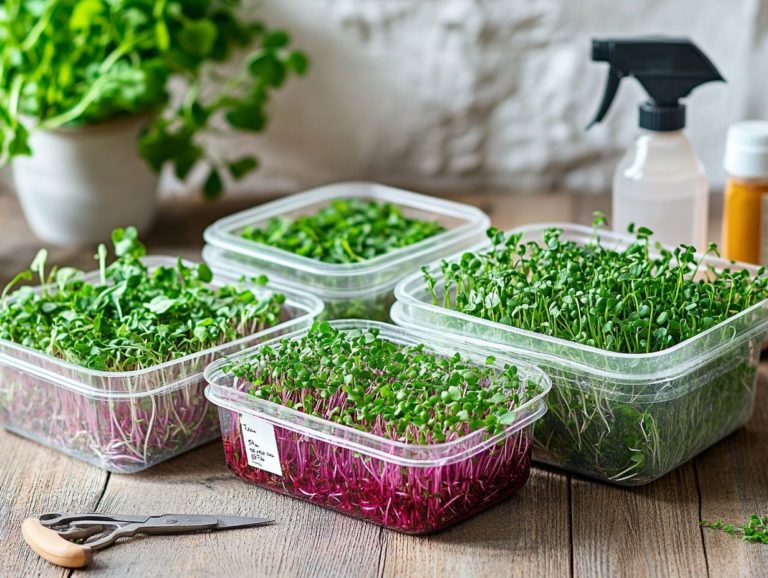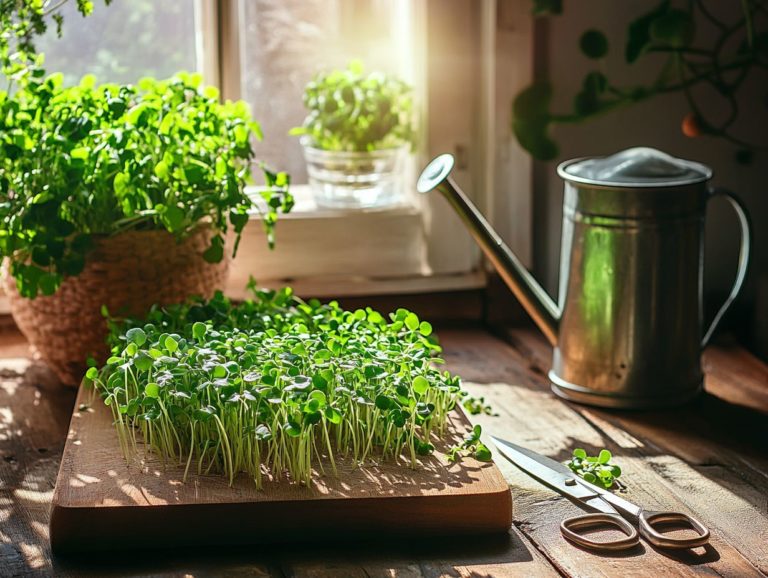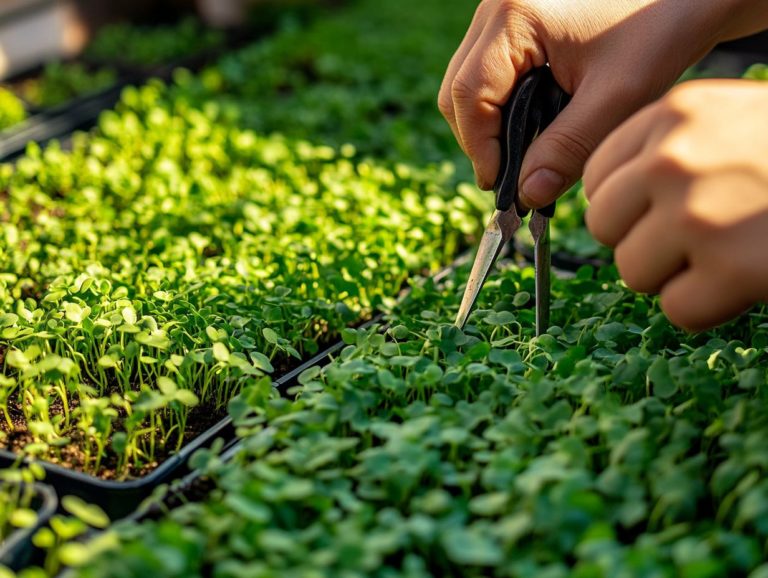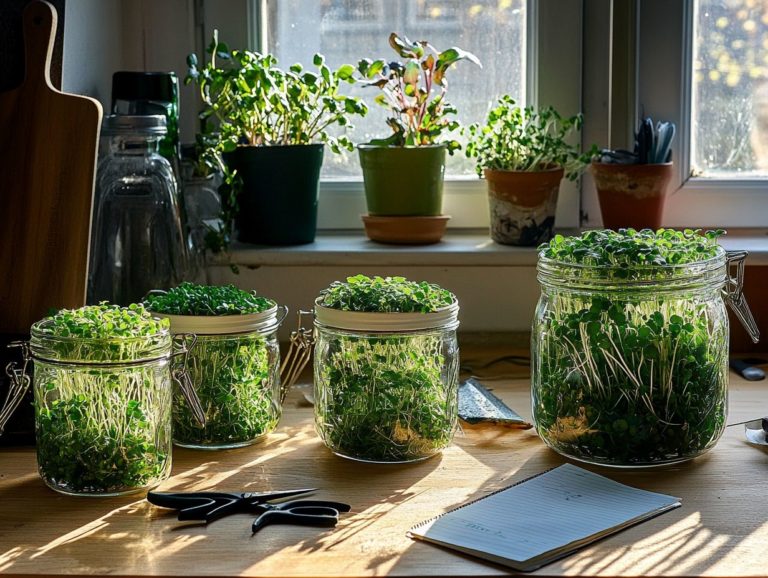The Benefits of Eating Freshly Harvested Microgreens
Microgreens, a type of nutrient-dense greens, can enhance the appeal of any dish. These young vegetables are not just a feast for the eyes; they re also packed with concentrated nutrients and offer an array of culinary uses, making them a favorite among chefs and home cooks alike. These tiny, nutrient-dense plants have captured the culinary world’s attention. Not only do they infuse dishes with vibrant colors and delightful flavors, but they also pack an impressive array of health benefits, including cancer prevention and diabetes management.
This article will delve into the nutritional advantages of microgreens, which offer concentrated nutrients and antioxidant properties compared to their mature counterparts, guiding you through a step-by-step process for growing and harvesting these gems. You ll also discover creative ways to incorporate them into your meals.
We will explore their role in sustainable farming and highlight the potential health benefits that make them an irresistible addition for any food enthusiast.
Get excited to discover why these petite greens are taking the culinary world by storm!
Contents
- Key Takeaways:
- Nutritional Benefits of Microgreens
- How to Grow and Harvest Microgreens
- Culinary Uses for Microgreens
- The Environmental Impact of Microgreens
- Potential Health Benefits of Microgreens
- Frequently Asked Questions
- What are microgreens?
- How do microgreens compare to full-grown vegetables?
- What nutrients can I expect to find in microgreens?
- How can eating microgreens benefit my health?
- Are there any specific types of microgreens that are especially beneficial to eat?
- How can I incorporate freshly harvested microgreens into my diet?
Key Takeaways:
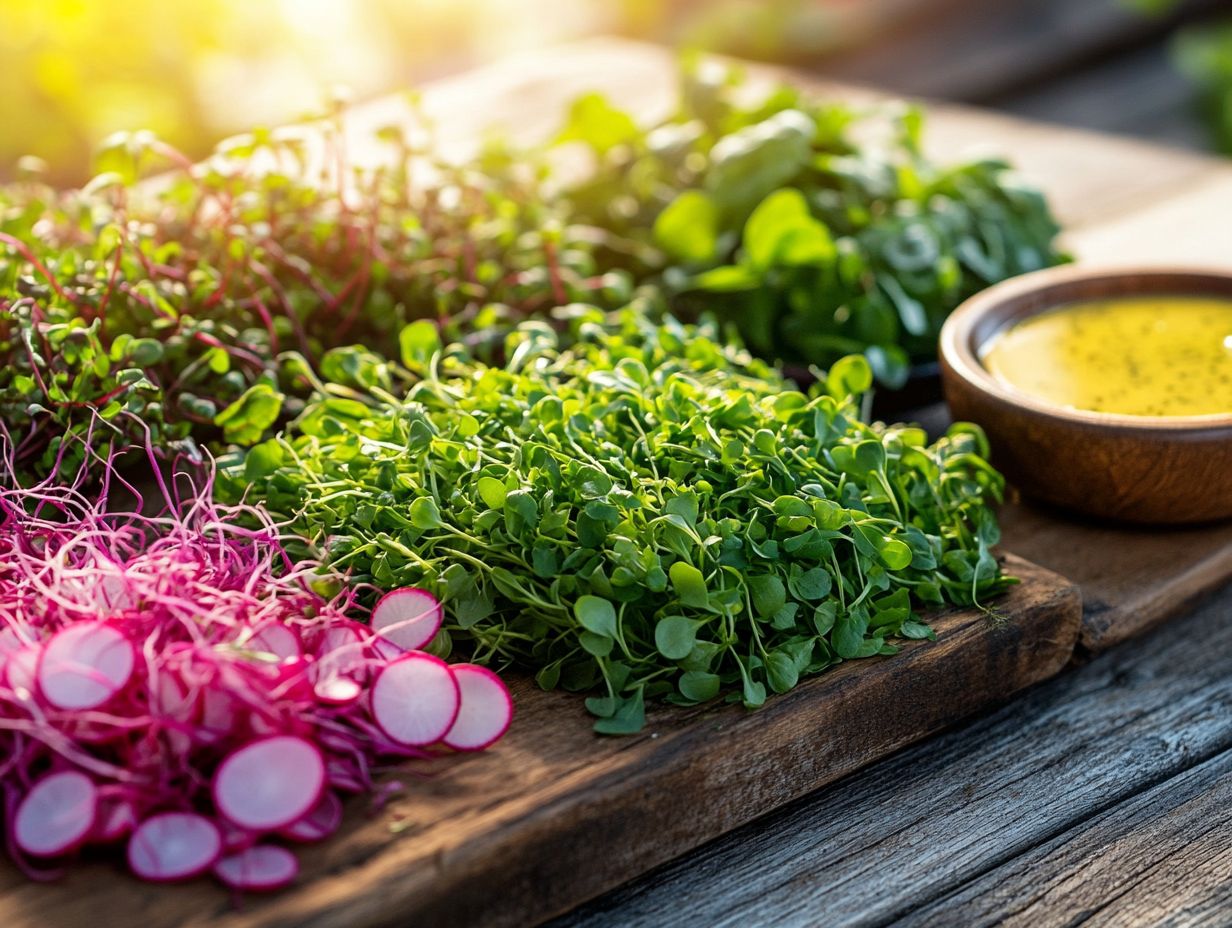
- Microgreens are young, nutrient-dense plants that offer a variety of health benefits and can easily be incorporated into everyday meals.
- Growing and harvesting microgreens at home is easy, making them a sustainable option for eco-conscious consumers.
- Research suggests that regularly consuming microgreens may help prevent and manage certain health conditions, adding value to a healthy diet.
What are Microgreens?
Microgreens are young, edible seedlings harvested from a variety of vegetables, herbs, and other plants, including those from the Brassicaceae family like broccoli and red cabbage. These vibrant and flavorful greens are packed with concentrated nutrients and offer an array of culinary uses, making them a favorite among chefs and home cooks alike.
With their ability to add a fresh and healthy touch to any meal, it’s no wonder you might be tempted to incorporate them into your cooking. Plus, they’re incredibly easy to grow at home, and their rich profile of vitamins, minerals, and antioxidants supports overall health, as highlighted in the role of microgreens in healthy eating.
Highly versatile, microgreens such as fenugreek and basil thrive in various growing conditions, requiring minimal space and effort. Typically cultivated in soil or hydroponic systems, these young plants are harvested just after the first true leaves appear, resulting in a burst of flavor that can elevate salads, sandwiches, and garnishes.
You’ll find that they contain higher concentrations of essential nutrients like vitamins C, E, and K compared to their mature counterparts. Sustainable cultivation methods, often relying on organic practices, make them an environmentally friendly addition to your kitchen. Their visual appeal, combined with their impressive health benefits, has firmly established them as a gourmet favorite.
Nutritional Benefits of Microgreens
Microgreens present a remarkable array of nutritional benefits that can elevate your meals. Renowned for their high levels of vitamins, minerals, and antioxidants such as vitamin C and iron these tiny powerhouses are more than mere flavorful garnishes.
They deliver concentrated nutrients that support various facets of health, making them essential for anyone striving to maintain optimal well-being.
Comparing Nutrient Content to Mature Plants
When you compare the nutrient content of microgreens to their fully matured plant counterparts, it becomes clear that these young vegetables often deliver concentrated nutrients in much higher quantities. This makes them an exceptional choice for elevating your dietary value. Research has demonstrated that microgreens can provide a more potent dose of vitamins and minerals, offering greater health benefits per serving.
For example, broccoli microgreens have been found to contain up to 40 times more vitamins E and C than their mature counterparts. In contrast, spinach microgreens boast higher concentrations of iron and magnesium compared to fully grown spinach. These remarkable differences suggest that including microgreens in your diet could significantly enhance your nutrient intake and, as highlighted in the benefits of growing diverse microgreen varieties, ultimately lead to improved overall health.
By opting for these vibrant young greens, you not only diversify your meals, but also boost your antioxidant levels, which may be crucial in reducing the risk of chronic diseases.
How to Grow and Harvest Microgreens
Cultivating microgreens is a gratifying and accessible venture that you can embark on using a variety of methods, including soil-grown and hydroponic techniques. Hydroponic techniques, where plants grow in nutrient-rich water instead of soil, are also popular. This versatility makes them a perfect choice for home gardening.
With just a handful of essential supplies and a few straightforward steps, you can easily grow these nutrient-dense greens, whether indoors or outdoors. They offer a sustainable and fresh enhancement to your meals, elevating your culinary experience effortlessly.
Step-by-Step Guide
This step-by-step guide is designed to simplify your journey into the world of microgreens. It ensures that even if you’re a beginner, you can easily cultivate these nutritious superfoods you need right in your kitchen. From selecting the perfect seeds to harvesting your crop, this guide serves as a comprehensive roadmap to achieving a thriving bounty of delicious microgreens.
With a keen eye for detail and a few foundational tips, you can effortlessly navigate the complexities of seed selection, optimal container choices, and the right care conditions. Choosing high-quality seeds that align with your taste preferences is crucial, as it influences not only the flavor but also the growth time and yield.
In terms of containers, selecting the appropriate size and ensuring proper drainage can greatly enhance your chances of success. By maintaining consistent moisture, providing ample light, and ensuring the perfect temperature, you ll be well-equipped to avoid common pitfalls like mold and stunted growth.
Embrace this tailored approach, and you ll soon be rewarded with vibrant, flavorful microgreens overflowing with nutrients.
Culinary Uses for Microgreens
Microgreens add a splash of excitement to your dishes, making them not only tasty but also visually stunning! They don t just add a pop of color; they bring vibrant flavors and textures that take your culinary creations to the next level.
Whether you re a professional chef or a home cook, you ll appreciate how these petite greens elevate everything from salads to sandwiches and garnishes. It s remarkable how such small additions can make a substantial difference in both presentation and taste.
Incorporating Microgreens into Meals
Incorporating microgreens into your meals can transform ordinary dishes into extraordinary culinary experiences, elevating both nutritional value and flavor. Whether you sprinkle them on a salad, blend them into smoothies, or use them as a garnish, these nutrient-rich greens can enhance the appeal of any dish and can be easily grown in various settings.
For example, adding a handful of peppery arugula microgreens to a creamy soup not only gives it a flavor punch but also boosts its vitamin content. In breakfast dishes, consider incorporating sunflower microgreens into your omelets or avocado toast for a satisfying and nourishing start to your day. To learn more about their advantages, check out the health benefits of microgreens explained.
Picture this: crafting a vibrant salsa verde with cilantro microgreens for a fresh twist on tacos. Start weaving these vibrant greens into your meals today and unlock a treasure trove of health benefits, such as improved digestion, enhanced immunity, and increased energy levels. For even more advantages, explore the benefits of indoor microgreen growing, all while savoring delightful new tastes in every bite.
The Environmental Impact of Microgreens
The environmental impact of microgreens is dramatically lower than conventional agriculture methods.
Microgreens are versatile and serve as a sustainable food source with minimal environmental impact.
By using minimal space and resources, you can cultivate microgreens indoors and outdoors while maintaining a small environmental footprint.
This makes them an attractive option for eco-conscious consumers like you.
Sustainable Farming Practices
Sustainable farming practices for growing microgreens focus on eco-friendly techniques that minimize environmental impact while maximizing health benefits.
These methods also yield nutrient-rich produce, foster biodiversity, and enhance soil health.
By integrating organic approaches, such as utilizing compost or natural fertilizers, you can boost soil fertility without introducing harmful chemicals.
Embracing permaculture principles encourages a harmonious relationship between plants, ensuring that resources are used efficiently.
Techniques like companion planting naturally deter pests while enhancing overall growth.
Cultivating microgreens locally not only shrinks your carbon footprint from transportation but also strengthens community bonds by providing fresh, accessible food options.
By adopting these sustainable practices, you play a crucial role in creating a healthier planet and enjoy the immediate rewards of fresh, vibrant produce right in your own backyard.
Potential Health Benefits of Microgreens

Research suggests that microgreens could provide a remarkable range of health benefits, particularly in the realms of disease prevention and management, especially for conditions such as cancer and Type 2 diabetes.
With their impressive antioxidant levels and a rich blend of vitamins and minerals, microgreens emerge as formidable allies in your quest for optimal health.
Research on Disease Prevention and Management
Recent health research has illuminated the significant role microgreens play in disease prevention and management.
These tiny powerhouses are packed with antioxidants and other health-promoting compounds that may help lower the risk of various health issues. Incorporating microgreens into a balanced diet can lead to improved health outcomes.
For example, certain varieties, such as broccoli and radish microgreens, contain a natural compound associated with cancer risk reduction by aiding in the detoxification of harmful substances.
Research suggests that adding microgreens to your meals can also assist in managing blood sugar levels, making them a beneficial choice for individuals with diabetes, as their fiber and nutrient content work to stabilize glucose levels.
Beyond these specific advantages, microgreens are overflowing with vitamins, minerals, and phytonutrients, all of which promote overall well-being and bolster the immune system.
Including these vibrant greens in your daily meals offers an effortless and delightful way to enhance nutrient intake and support long-term health.
Summary of Benefits and Recommendations
Many benefits come from incorporating microgreens into your healthy diet. These tiny greens offer a concentrated source of nutrients that can significantly enhance your overall well-being. Don t wait start adding a variety of these young vegetables to your meals today!
Integrating microgreens into your daily dishes can elevate the nutritional profile of your meals. They introduce vibrant flavors and textures while boosting your vitamin and mineral intake. To maximize your microgreen harvest, consider exploring the benefits of multi-layer microgreen growing. Whether you sprinkle them on salads, blend them into smoothies, or use them as a garnish for main courses, these little powerhouses can transform ordinary meals into nutrient-rich foods.
Research shows that consuming microgreens can support immune function and promote better digestion. This makes them a smart choice for anyone looking to improve their diet. For optimal benefits, it’s wise to incorporate a diverse range of microgreens, including those grown vertically, to ensure you get a broad spectrum of nutrients. Check out the benefits of growing microgreens vertically for more insights.
Consulting a registered dietitian can provide tailored advice on how to integrate these nutrient-rich plants into your eating habits, ensuring a balanced approach to your health and well-being.
Frequently Asked Questions
What are microgreens?
Microgreens are young vegetable shoots harvested in just 1-3 weeks. They’re nutrient-packed and a tasty addition to any meal!
How do microgreens compare to full-grown vegetables?
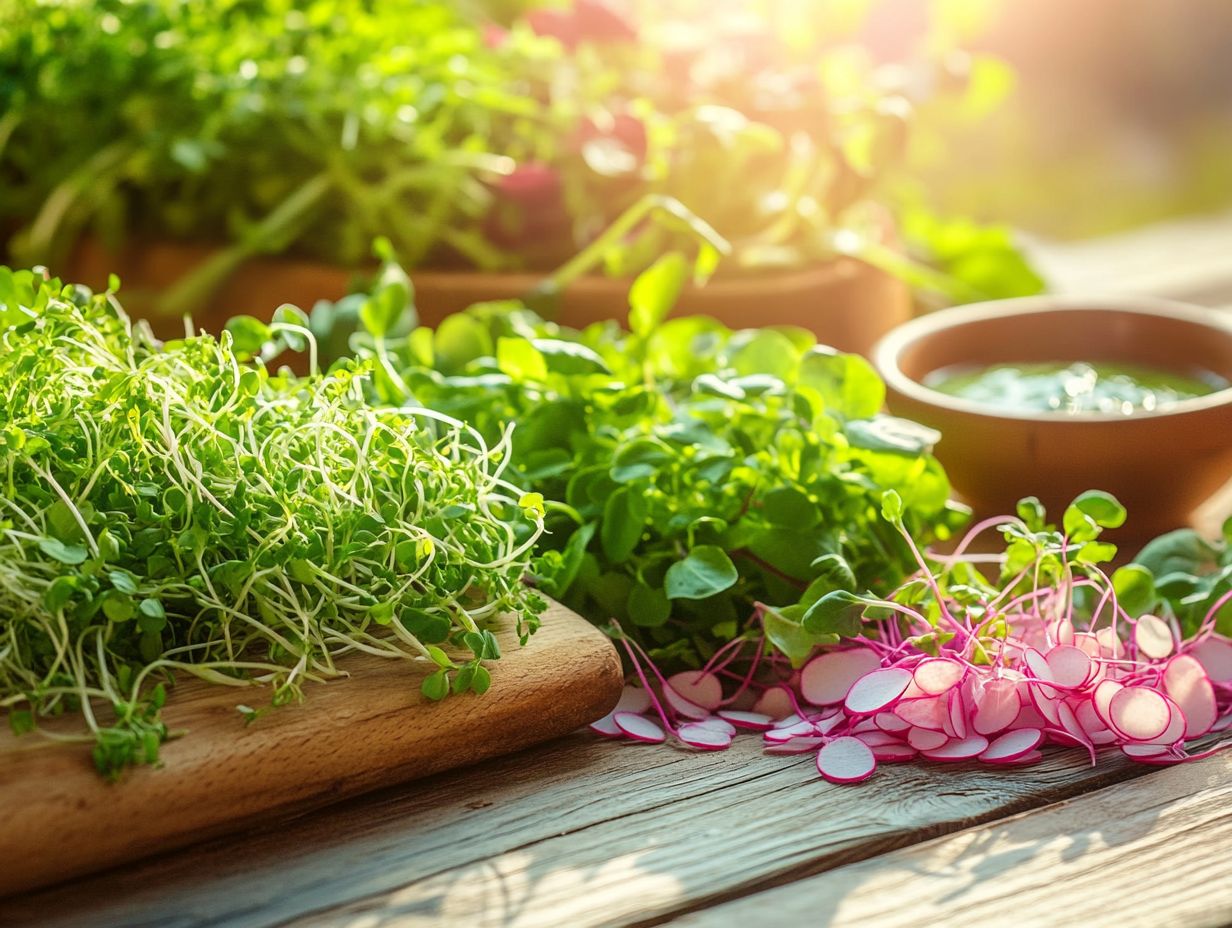
Studies have shown that microgreens can contain up to 40 times more nutrients than their mature counterparts. By eating just a small amount of microgreens, you can get the same nutritional benefits as eating a larger amount of the full-grown vegetable.
What nutrients can I expect to find in microgreens?
Microgreens are rich in vitamins, minerals, and antioxidants. Popular varieties, such as broccoli and kale, are high in vitamins A, C, and K, as well as folate and fiber. Others, like sunflower and pea shoots, are good sources of protein.
How can eating microgreens benefit my health?
The high nutrient content of microgreens can help boost your immune system, improve digestion, and promote overall health and wellness. They may also help reduce the risk of chronic diseases such as heart disease, diabetes, and certain types of cancer.
Are there any specific types of microgreens that are especially beneficial to eat?
While all microgreens offer numerous health benefits, some varieties may have specific advantages. For example, red cabbage microgreens are high in anthocyanins, a type of antioxidant that may help protect against cancer and heart disease. Sunflower microgreens are a good source of vitamin E, which is important for skin health and immune function.
How can I incorporate freshly harvested microgreens into my diet?
Microgreens are very versatile. You can add them to salads, sandwiches, smoothies, and stir-fries. They also work well as a garnish for soups or cooked as a side dish. The possibilities are endless, so get creative and enjoy the health benefits of eating freshly harvested microgreens!

